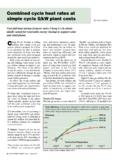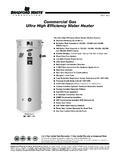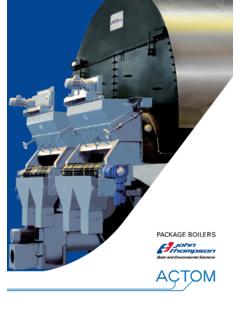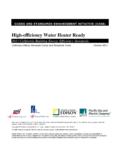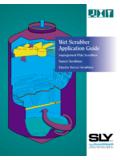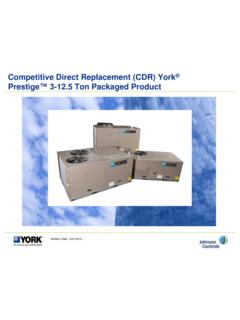Transcription of Lodi’s 300MW Flex 30 plant ushers in a new era for …
1 10 GAS TURBINE WORLD: September October 2012 Lodi s 300MW flex 30 plant ushers in a new era for the USThe Lodi Energy Center, owned and operated by the Northern California Power Agency, is the first operating Siemens flex plant 30 com-bined cycle gas turbine power plant in the US. Key operational features: Output. Lodi has nominally rated the plant at 300MW base load which is a bit lower than its design rating. Duty cycle. Designed for interme-diate to continuous duty and capable of daily cycling. Ramp rate. Can ramp up or down at MW/min and turndown in standard emissions compliance to less than 50 per cent has set very ambitious car-bon reduction targets and renewable energy goals under the 2006 climate change act and 33 per cent renew-able portfolio standard requirement of 2011 with its associated need for fast start backup power.
2 As intermittent sources such as wind and solar PV grow, so does the need for back-up power plants that are able to provide power quickly when the wind does not blow and the sun does not shine. Gas-fired plants are widely regarded as the best option for providing this back-up. In August, the Northern California Power Agency inaugurated the Lodi Energy Center (LEC) the first op-erating Siemens flex - plant 30 com-bined cycle gas turbine power plant in the USA is designed for intermediate to continuous duty and is capable of daily configurationThe LEC plant is designed around a 208MW natural gas-fired SGT6-5000F gas turbine with evaporative air inlet cooling and dry low NOx combustors to control air emissions, 3-pressure Nooter Eriksen heat recov-ery steam generator, selective catalyt-ic reduction (SCR) and carbon mon-oxide (CO) catalyst to further reduce emissions, and a 100MW SST-900RH condensing steam turbine generator.
3 According to Siemens, overall plant start-up times are reduced by up to 50 per cent due to the integra-tion of fast start-features, including the three-pressure HRSG with Ben-son once-through technology, high ca-pacity steam attemperation (desuper-heating), full capacity steam bypass systems, innovative piping warm-up By Junior IslesThe Siemens flex plant 30 at Lodi designed to deliver 200MW of power to the grid within 30 minutes of startup is capable of daily cycling at over 57 percent combined cycle plant expected to have over 95 percent annual availability Lodi Energy Center s design to combine operating flexibility with the ability to quickly start up and provide efficient part-load and base load power calls for a high degree of redundancy. Lodi is expected to operate with an annual availability factor of more than 95 percent, calculated as the percentage of time that the plant is able to generate power determined in large part by the reliability of critical operating equip-ment and maintenance shutdown ensure operational reliability and availability, Lodi has installed a number of back-up ancillary systems including: two 100 percent fuel gas compressors; two 100 percent capacity feed water pumps; two 100 percent capacity condensate pumps; two 100 percent capacity circulating water pumps; two 100 percent capacity air compressors; and extra capacity 7-cell evaporative cooling plant also incorporates an evaporative cooling tower to cool the steam turbine s condenser.
4 Recycled water for process and cooling water uses will be delivered from an adjacent City of Lodi s water pollution control facility and an onsite well will provide potable water. GAS TURBINE WORLD: September October 2012 11 strategies, and Siemens steam turbine stress controller (STC). The latest version of the SGT6-5000F gas turbine at the heart of the plant is capable of reaching full out-put in 30 minutes. It also can ramp up or down at a rate of MW/min and remain compliant with emissions regulations below 50 percent part-load turndown conditions. Fast-start design According to Siemens, its fast start capability to deliver 200 MW in 30 minutes or less can result in a 30 per cent reduction in greenhouse gas emissions when compared to tradi-tional F-class combined cycle plants more than 200 t/year of carbon monoxide.
5 Lodi flex 30 project. First operating Siemens flex 30 combined cycle gas turbine power plant in the United States is nominally rated at 300MW net plant output and net flex 30 combined cycle project Lodi has nominally rated its flex 30 plant at 300MW net output at an expected net plant efficiency, including all BOP 1x1 plant Net plant output* 307,000 kWNet heat rate LHV 5990 Btu/kWhNet plant efficiency Lodi flex 30 plant Net plant output** 300,000 kWNet heat rate (LHV) 6000 Btu/kWhExpected efficiency Installed plant cost** 1300 $/kWOperating cost (est) $90 million/yr Rated power capacity** 2,400,000 MWh/yrExpected operation 1,600,000 MWh/yr Sources: 2012 GTW Handbook* and Lodi Energy Center**12 GAS TURBINE WORLD: September October 2012 Since its first introduction in 1993, the engine has evolved over time with improvements made to increase ef-ficiency and power output, extend maintenance intervals and enhance operating flexibility.
6 According to Siemens, the engine is now designed for high reliability and frequent ramp-ing and has no service penalty for fast starting or fast ramping. It features a 13-stage compressor with four rows of variable compressor guide vanes enabling high efficiency at part load as well as at base load. The compressor is connected to the 4-stage turbine by a single tie-bolt. No nickel-based alloys are used in the rotor construction. Instead the rotor uses upgraded steel discs in the turbine section with a rotor air cooler to allow for greater flexibility in tur-bine blade cooling air temperature. Ultra low NOx The engine is offered with an option of two combustion systems. The lat-est version of the turbine uses an ultra low NOx (ULN) combustion system that employs 16 can-annular combus-tors to reduce NOx levels to less than 9 ppm.
7 The ULN system uses five fuel stages to mix the natural gas with combustion air. The pilot and the main pre-mixers on the combustor support housing employ swirler fuel injection, where the fuel is injected off the swirler vanes. This provides more injection points and better mix-ing than the previous dry low NOx combustor. In addition to reducing NOx, the ULN combustion system controls CO, volatile organic compounds and par-ticulate emissions. The reduction in low-load CO emissions is achieved by operational modifications and bypass-ing supplemental cooling air around the combustor. The result of bypassing air around the combustor is increased combustor flame temperature, which leads to re-duced CO production.
8 In this version, CO emissions are kept below 10 ppm down to at least 40% load, without alteration to the internal architecture of the combustion system. This allows greater flexibility during cyclic opted for standard DLNLodi passed up the ULN option in fa-vor of a standard 25 ppm DLN com-bustion system and rely on catalytic reduction to reduce plant emissions to less than 2 ppm NOx in line with California environmental regulations. Likewise, Lodi chose to equip its gas turbine with a standard motor and torque converter starter, with a turn-ing gear speed of 3 rpm. To achieve improved gas turbine start capability, the gas turbine could have been supplied with a static fre-quency converter (SFC) starter in-stead of a mechanical starter (with SFC design, the generator operates as a motor).
9 The SFC unit allows more efficient and faster rotor acceleration than an equivalent size mechanical starting motor. It can increase the turning gear speed from 3 rpm, for earlier models, to 120 rpm. Higher turning gear speed enables the generator rotor wedges to lock up, prevents compressor blade locking mechanism wear, and locks turbine blades into running position. The higher speed also helps the engine to cool down faster, because the turbine parts are cooled faster and blade tip clearances are similar to the cold tip cycle integrationAlthough flexible gas turbines can start fast, once deployed into com-bined cycle mode, steam cycle con-straints need to be considered. The gas turbine is exhausting a high vol-ume of high temperature air and the heat sink needs to be able to absorb and dissipate that energy without damaging any equipment.
10 In a traditional combined cycle power plant , the ramp rate of the gas turbine is constrained by limitations imposed by equipment in the bottom-ing cycle. To protect that equipment, the gas turbine is ramped to a low-load hold point letting the rest of the cycle warm up and allowing time to achieve appropriate steam chemistry then ramped a bit more. At this hold point, the gas turbine produces much higher CO emissions than at base load, so the result is low power and high emissions during the hold. Typically the gas turbine in a three-pressure, reheat combined cycle arrangement experiences two such holds prior to allowing the steam turbine to go to a valves wide open condition. Several changes were made to re-move these constraints, the first of which was a change in boiler design.
